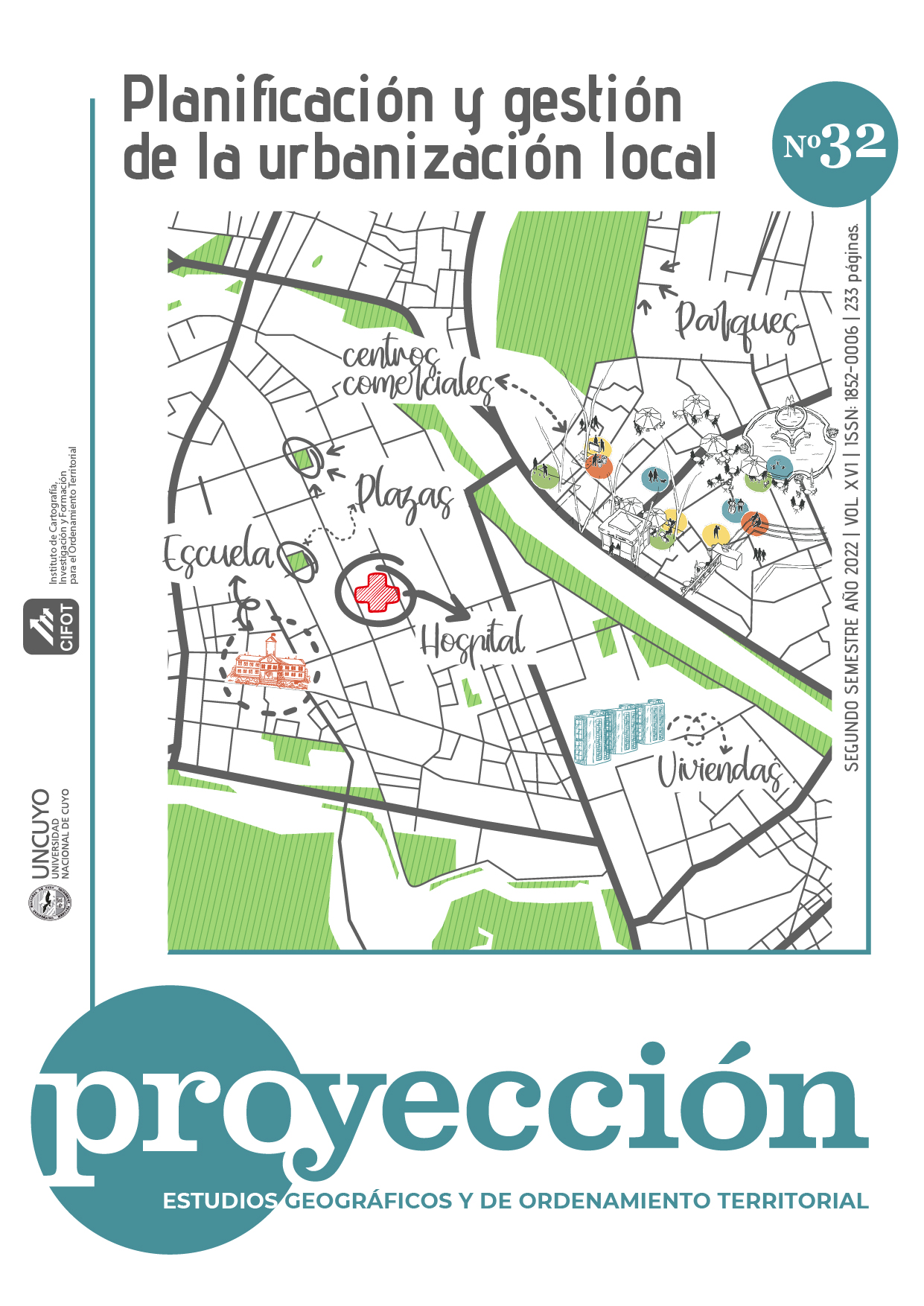Regularización dominial: Implementación estatal, representaciones y reconocimiento de la tenencia.
El caso de La Matera, Municipio de Quilmes
DOI:
https://doi.org/10.48162/rev.55.030Palabras clave:
capacidades estatales, tenencia informal, representaciones sociales, regularización dominialResumen
Las políticas de regularización dominial se han extendido en Argentina desde los años 90’, siendo por lo general contrapuestas a las políticas de regulación integrales. A pesar de sus dificultades de implementación, la emisión de certificados de dominio, aún no equivalentes a las escrituras, genera apropiaciones que exceden los objetivos iniciales de estas políticas. La representación social de estos programas resulta central para comprender la complejidad de la presencia estatal en el territorio, las transformaciones de la espacialidad y los modos de reconocimiento de la tenencia. El artículo aborda estas construcciones de sentido en un caso que puede ser considerado de regularización mixta. Se describe ese proceso junto con el modo en que habitantes de un barrio del Municipio de Quilmes tematizan las diversas formas de reconocimiento estatal presentes en estas políticas, el modo en que ellas recrean la informalidad de la tenencia y cómo las representaciones sociales reconstruyen la capacidad estatal de regularizar la posesión, incluso en mayor medida que las políticas públicas. La investigación siguió un diseño de tipo cualitativo, llevándose a cabo entrevistas semi-estructuradas y abordando diferentes perfiles de trayectoria habitacional, en vistas a su afinidad con diferentes sentidos de la escrituración.
Citas
AUYERO, J. (2007). La zona gris: violencia colectiva y política partidaria en la Argentina contemporánea. Buenos Aires: Siglo XXI.
BACHILLER, S. (2018). Legalidades alternativas y tomas de tierras en una ciudad de la Patagonia argentina. Estudios atacameños, 275-296.
BOURDIEU, P. (2014). Lecciones sobre el Estado. Barcelona: Anagrama.
CASTELLS, M., & PORTES, A. (1989). The informal economy: Studies in advanced and less developed countries,. Baltimore: John Hopkins University.
CLICHEVSKY, N. (2000). Informalidad y segregación urbana en América Latina: una aproximación. Santiago de Chile: Cepal.
CRAVINO, M. C. (2009). La metamorfosis de la ciudad informal en el Área Metropolitana de Buenos Aires. Líder, 31-55.
CRAVINO, M. C., & VOMMARO, P. (2018). Asentamientos en el sur de la periferia de Buenos Aires: orígenes, entramados organizativos y políticas de hábitat. Población y Sociedad, 1-27.
DE SOTO, H., GHERSI, E., & GHIBELLINI, M. (1987). El otro sendero. México: Diana.
DI VIRGILIO, M. M., GUEVARA, T., & ARQUEROS, M. S. (2010). Veinte años no es nada. Procesos de regularización de villas y asentamientos informales en la Región Metropolitana de Buenos Aires. Scripta Nova, Revista electrónica de geografía y ciencias sociales, 1-20.
FERNANDES, E. (2008). Consideraciones generales sobre las políticas públicas de regularización de asentamientos informales en América Latina. EURE, 25-38.
GUEVARA, T. (2016). ¿Y el título para cuándo? El proceso de regularización del barrio Virgen Misionera. Cadernos Metrópole, 119-144.
JODELET, D. (1984). La representación social. Fenómeno, concepto y teoría. En S. Moscovici, Pensamiento y vida social (págs. 469-494). Barcelona: Paidós.
LEFEBVRE, H. (2013). La producción del espacio. Madrid: Capitán Swing.
MANEIRO, M. (2020). Conflictos acerca de las cualidades del espacio. Un estudio en tres barrios periféricos surgidos a partir de ocupaciones de tierras en el Gran Buenos Aires. Gavagai, 8-32.
MANEIRO, M., & BAUTÉS, N. (2017). Retomar la informalidad. Un abordaje desde su dimensión política. O Social em Questão, 39-56.
MANN, M. (1997). Las fuentes del poder social. Madrid: Alianza.
MOSSE, E. (2019). La construcción histórica del beneficiario: políticas de regularización dominial en Santa Fe (1985-2017). Revisgta de Derieto da Cidade, 621-662.
NARDIN, S. (2019). Memorias sobre tomas de tierra en San Francisco Solano: acción directa, vínculo de ciudadanía y distinciones sociales . Tesis de maestría, Universidad Nacional de General Sarmiento.
OSTUNI, F., & VAN GELDER, J. (2019). No sé si es legal… ¡pero legítimo es…!” Percepciones sobre la seguridad en la tenencia y títulos de propiedad en barrios informales del Gran Buenos Aires. En M. C. Cravino, Los mil barrios (in)formales (págs. 201-219). Los Polvorines: UNGS.
RELLI UGARTAMENDIA, M. (2011). Notas sobre la política de la provincia de Buenos Aires frente a la irregularidad dominial del hábitat popular urbano, 1990-2005. En M. M. Di Virgilio, La cuestión urbana interrogada (págs. 75-107). Buenos Aires: Café de las ciudades.
ROY, A. (2005). Urban Informality. Toward an Epistemology of Planning. Journal of the American Planning Association, 147-158.
SIGAL, S. (1981). Marginalidad espacial, Estado y Ciudadanía. Revista mexicana de sociología , 1547-1578.
ZARAZAGA, R. (2017). Punteros, el rostro del Estado frente a los pobres. En L. Z. Rosconi, Conurbano infinito: actores políticos y sociales, entre la presencia estatal y la ilegalidad (págs. 19-63). Buenos Aires: Siglo XXI.
Publicado
Cómo citar
Número
Sección
Licencia
Derechos de autor 2022 Javier Nuñez

Esta obra está bajo una licencia internacional Creative Commons Reconocimiento-NoComercial-CompartirIgual 3.0.
La revista Proyección establece las siguientes condiciones de publicación para los/as autores/as:
- Los/as autores/as conservan los derechos de autor y ceden a la revista el derecho de publicación bajo la Licencia Creative Commons Atribución-No Comercial-CompartirIgual 3.0 No portada (CC BY-NC-SA 3.0) que permite a terceros copiar, distribuir, exhibir y ejecutar la obra citando siempre la fuente y los datos de autoría según la norma prevista por la Revista Proyección. Esta licencia no permite el uso de la obra con fines comerciales.
- Todos los trabajos publicados por Proyección, Estudios Geográficos y de Ordenamiento Territorial serán bajo la modalidad de gratuidad para autores/as y lectores/as.




























